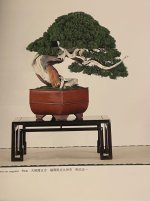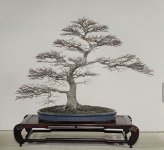bwaynef
Masterpiece
Does anyone want to discuss exhibition album photos? I won’t pick out necessarily the best. Just ones I find interesting. Also, I’ll try to identify the show but might not have that information handy anymore.
Let’s see where this goes.
Kokufu 93
This was one of the Kokufu prize winners for the first half of the show. I was a bit surprised when I saw it. While it does have movement and deadwood, they doesn’t come in the volume so often seen in Kokufu, much less among prize winners. It has an undeniable grace but also a bit of tension (not necessarily in the Mirai sense) and uneasiness.
Let’s see where this goes.
Kokufu 93
This was one of the Kokufu prize winners for the first half of the show. I was a bit surprised when I saw it. While it does have movement and deadwood, they doesn’t come in the volume so often seen in Kokufu, much less among prize winners. It has an undeniable grace but also a bit of tension (not necessarily in the Mirai sense) and uneasiness.





















